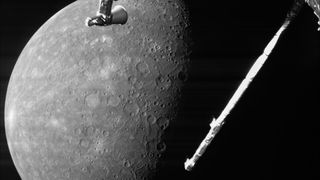BepiColombo probe captures stunning Mercury images in closest flyby yet
"It is a world of extremes and contradictions, so I dubbed it the ‘Problem Child of the Solar System’ in the past."

The BepiColombo Mercury probe made a flyby of its ultimate destination on Wednesday, capturing superb images of the planet's crater-covered crust.
The joint European-Japanese BepiColombo spacecraft, which launched in 2018, swooped in for its fourth Mercury flyby at 5:48 p.m. EDT (2148 GMT) Sept. 4, passing just 103 miles (165 kilometers) above the surface of the solar system's innermost planet.
The gravity assist maneuver is part of what will be the probe's eight-year voyage to enter orbit around Mercury, helping to reduce the spacecraft's speed to keep the trip on track. But beyond that, the maneuver also delivered some of the mission's best images so far, using BepiColombo's three monitoring cameras, or M-CAMs.
The images include two significant impact craters: Vivaldi, named after the famous Italian composer Antonio Vivaldi, and the newly named Stoddart crater, named for New Zealand artist Margaret Olrog Stoddart.
Related: Thruster issues delay BepiColombo probe's Mercury arrival until November 2026
Both craters feature peak ring basins, created by large asteroid or comet impacts. The images help reveal more about the craters' complex history and Mercury's volcanic history. The image of Vivaldi also shows a discernible gap in the ring of peaks — this was created when more recent lava flows entered and flooded the crater.
"Mercury's peak ring basins are fascinating because many aspects of how they formed are currently still a mystery. The rings of peaks are presumed to have resulted from some kind of rebound process during the impact, but the depths from which they were uplifted are still unclear," David Rothery, professor of Planetary Geosciences at the U.K.'s Open University and a member of the M-CAM imaging team, said in a statement.
Get the Space.com Newsletter
Breaking space news, the latest updates on rocket launches, skywatching events and more!
BepiColombo was scheduled to enter orbit around Mercury in December 2025. However, a propulsion system issue meant the spacecraft's thruster could no longer operate at full power. After months of assessment, ESA teams designed a revised trajectory, meaning Wednesday's flyby was closer than originally planned. BepiColombo is now planned to enter orbit in November 2026.
The flyby, while providing epic views of the results of 4.6 billion years of cosmic bombardment, also provided scientific measurements of Mercury's magnetic, plasma and particle environments, offering insights from areas that won't be accessible once BepiColombo officially enters orbit. Two final flybys are planned in December 2024 and January 2025.
"It is a world of extremes and contradictions, so I dubbed it the 'Problem Child of the Solar System' in the past," Jack Wright, ESA Research Fellow, Planetary Scientist and M-CAM imaging team coordinator, said in the statement.
"The images and science data collected during the flybys offer a tantalizing prelude to BepiColombo's orbital phase, where it will help to solve Mercury's outstanding mysteries."
BepiColombo aims to spend at least a year, and possibly two, revealing the mysteries of Mercury with a suite of 16 instruments. These are spread across two orbiters, one each developed by ESA and the Japan Aerospace Exploration Agency (JAXA). The two will separate once in orbit around Mercury.
Join our Space Forums to keep talking space on the latest missions, night sky and more! And if you have a news tip, correction or comment, let us know at: community@space.com.

Andrew is a freelance space journalist with a focus on reporting on China's rapidly growing space sector. He began writing for Space.com in 2019 and writes for SpaceNews, IEEE Spectrum, National Geographic, Sky & Telescope, New Scientist and others. Andrew first caught the space bug when, as a youngster, he saw Voyager images of other worlds in our solar system for the first time. Away from space, Andrew enjoys trail running in the forests of Finland. You can follow him on Twitter @AJ_FI.